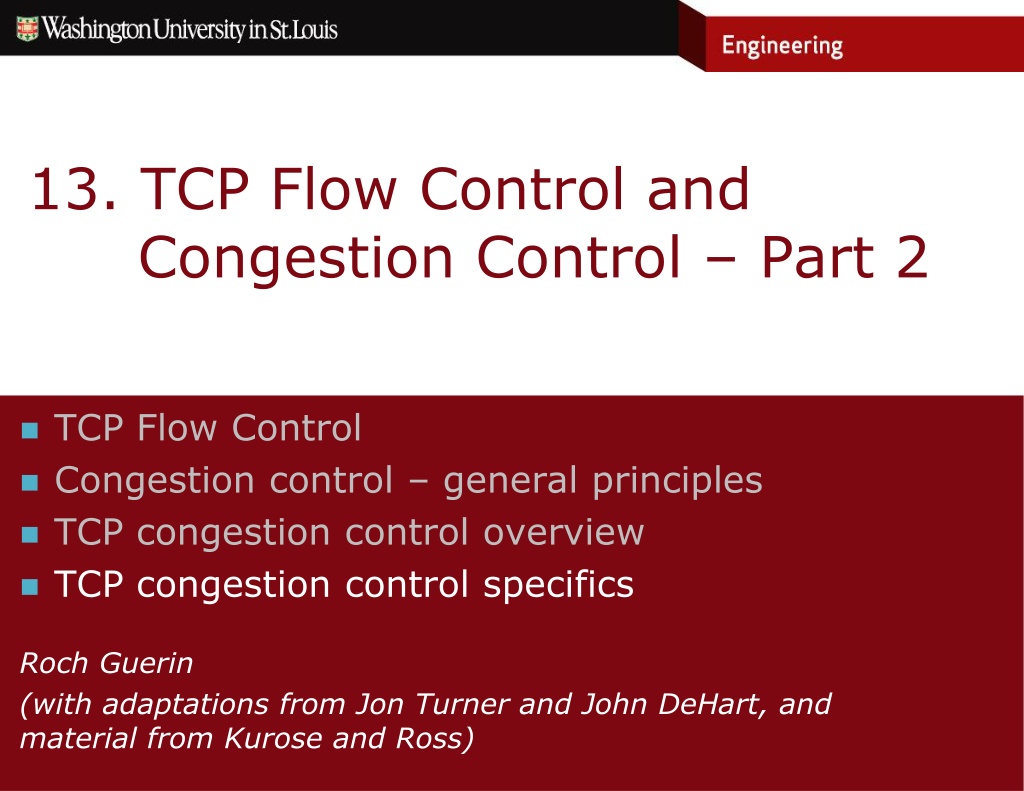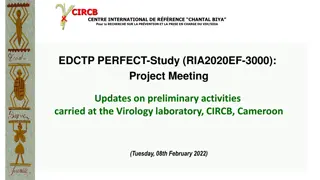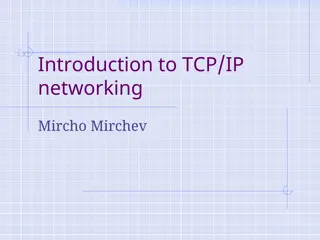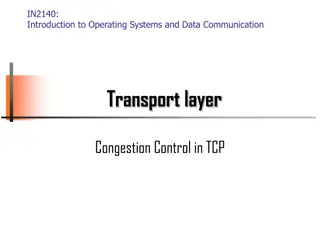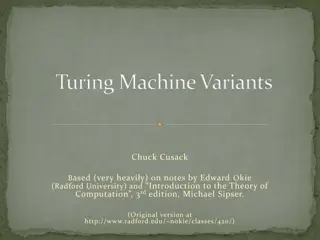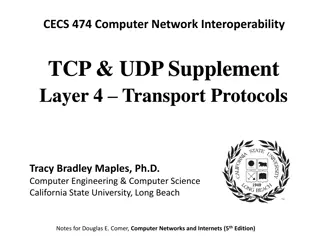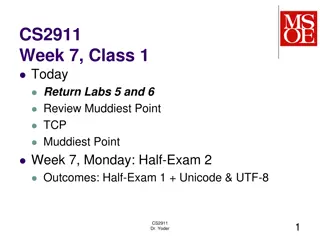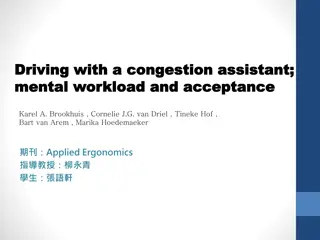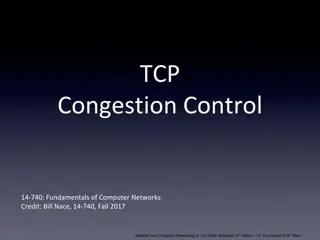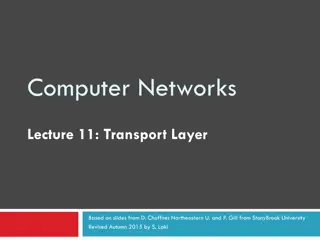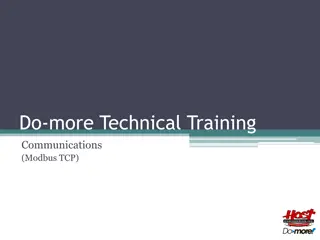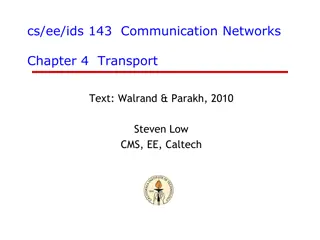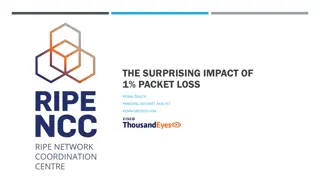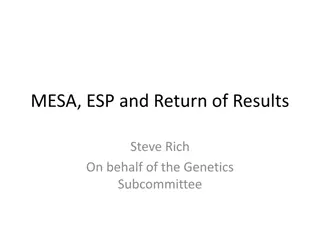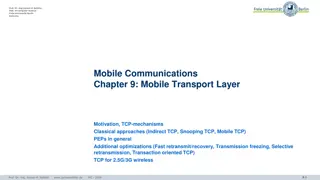Understanding TCP Flow Control and Congestion Control Variants
The text delves into TCP flow control and congestion control mechanisms, focusing on TCP Tahoe and Reno variants. It explains the sender-side congestion control algorithms, such as AIMD, slow start, and fast recovery. Details of TCP variants like BIC and CUBIC are also discussed, highlighting their impact on congestion response in different network types. Additionally, insights on TCP congestion control availability and settings in ONL are provided, offering a comprehensive overview of the topic.
Download Presentation

Please find below an Image/Link to download the presentation.
The content on the website is provided AS IS for your information and personal use only. It may not be sold, licensed, or shared on other websites without obtaining consent from the author. Download presentation by click this link. If you encounter any issues during the download, it is possible that the publisher has removed the file from their server.
E N D
Presentation Transcript
13. TCP Flow Control and Congestion Control Part 2 TCP Flow Control Congestion control general principles TCP congestion control overview TCP congestion control specifics Roch Guerin (with adaptations from Jon Turner and John DeHart, and material from Kurose and Ross)
TCP Congestion Control Variants A series of congestion control algorithms have been developed and used for TCP the differences affect only the sender-side of a TCP connection, so hosts running different versions of TCP can still communicate TCP Tahoe the original approach developed in the late 1980s basic AIMD + slow-start strategy TCP Reno and New Reno New Reno is now most widely deployed approach added a transient fast recovery operating mode to TCP BIC and CUBIC provides faster congestion response in high speed networks CUBIC is now the default choice in Linux We will focus on Tahoe and Reno 2
TCP Congestion Control in ONL Currently available: /proc/sys/net/ipv4/tcp_available_congestion_control Reno (default) /proc/sys/net/ipv4/tcp_congestion_control CUBIC Present as loadable kernel modules: /lib/modules/3.2.0-75-generic/kernel/net/ipv4/tcp_*.ko BIC (Binary Increase Congestion) High Speed (RFC 3649) H-TCP Hybla Illinois Vegas Veno Westwood Yeah Etc. 3
TCP Tahoe Overview TCP sender has two primary operating states congestion avoidance increase sending rate in small increments slow start (slow compared to jumping right away to a window equal to RcvWindow) more rapid initial rate increases (from a starting rate of 1 MSS/RTT) also entered after a packet loss is detected two ways to detect loss: timeout or triple duplicate ack Sender maintains two control congestion variables 1. congestion window (cwnd): limits number of unack-ed bytes 2. slow start threshold (ssthresh): controls when sender leaves the slow-start state updated in response to lost packets and reception of ACKs 4
TCP Tahoe Details new ack cwnd = cwnd + MSS/(cwnd/MSS) new ack cwnd = cwnd +MSS cwnd ssthresh do nothing initialization cwnd = MSS ssthresh = RcvWindow slow start congestion avoidance lost segment ssthresh = cwnd/2 cwnd = MSS retransmit lost segment ssthresh = cwnd/2 cwnd = MSS retransmit Updating cwnd in slow start, cwnd is effectively doubled each RTT (if no loss) in congestion avoidance, cwnd grows by about 1 MSS per RTT After transition from congestion avoidance to slow start it takes about 1 RTT for a new ACK to arrive and nothing much happens during this period after ACK arrives, # of unACK-ed bytes becomes 0, sender can resume sending, and cwnd grows as ACKs arrive 5
What Is Slow Start? A new source starts with a small (1 MSS) window, but is allowed to increase it quickly initially cwnd = 1 MSS increases by 1 MSS for each ACK cwnd is effectively doubled for every RTT with no packet loss stops when cwnd reaches ssthresh if packet loss encountered, set ssthresh = cwnd/2, cwnd = 1 MSS, and continue in slow-start state Slow-start is fast compared to regular additive increase, but slow compared to jumping directly to ssthresh = RcvWindow Host B Host A RTT time 6
Ending Slow-Start Slow-start ends when cwnd = ssthresh Assume ssthresh = 64 kbytes and MSS = 1 kbytes cwnd progression Start with cwnd = 1 MSS After ~1 RTT cwnd increases to 2 MSS Sends two packets back to back First ACK comes back 1 RTT later, and the second 1 packet transmission time after that, at which time cwnd = 4 MSS Progression proceeds for 6 RTTs plus ~32 packet transmission times, at which point cwnd = 26 = 64 MSS and TCP exits slow-start and enters congestion avoidance 7
A Typical TCP Pattern cwnd Packet loss 20 cwnd0 ssthresh0 Congestion avoidance 15 ssthresh1= cwdn0/2 10 Slow start 5 0 RTT 8
Another Possible TCP Pattern cwnd cwnd = 64 kbytes ssthresh0 Congestion avoidance ssthresh1= cwdn0/2 Slow start Now lets look at Review questions For lecture 12 To see some details 0 RTT 9
TCP Transmission Patterns 1. cwnd < RTT x BW Packet transmission time cwnd packets cwnd packets cwnd packets > < ACKs ACKs ACKs RTT 2. cwnd RTT x BW (excess transmissions buffered in the network) cwnd packets Packet transmission time > < ACKs RTT 10
TCP Reno Fast Retransmit & Recovery Fast Retransmit (don t wait for time-out) Tahoe & Reno Packet loss triggers duplicate ACKs for each subsequent segment received at destination Receipt of three duplicate ACKs (provision for out-of-order packets) is taken as an indicator of a lost packet retransmit lost packet Tahoe: go to "slow-start : ssthresh = cwnd0/2 and cwnd = 1 MSS Reno: go to Fast Recovery 11
TCP Reno Fast Retransmit & Recovery Fast Recovery (jump directly to cwnd/2 after loss) set cwnd = ssthresh + 3 MSS, i.e., cwnd0/2 + 3 MSS, and increase by 1 for each duplicate ACK received (why + 3MSS?) accounts for transmitted packets that leave the network typically allows for transmission of cwnd0/2 worth of new packets (jump directly to new halved transmission rate) cwnd grows from cwnd0/2 to cwnd0/2 + cwnd0 - 1 = 3*cwnd0/2 -1, which allows cwnd0 - 1 new packets plus the retransmitted packet for a total of cwnd0/2 transmitted packets ends when ACK for missing packet is received (after RTT) if loss caused by time-out, go to slow-start as before time-out usually requires multiple packet losses, which is indicative of more severe congestion Why? What conditions are required to cause a timeout? 12
Fast Recovery Example Assume cwnd = 16 and the first packet (SEQ=1) is lost Note that previous ACK already asked for packet 1 Receipts of packets 2, 3, and 4 each generate an ACK asking for packet 1 triple duplicate ACK (congestion detected) ssthresh = 16/2=8, cwnd = ssthresh+3 = 11 (but 16 pending packets) retransmit packet 1 Receipts of packets 5 to 16 generate 12 more ACKs asking for packet 1 cwnd increases 11+12 = 23 can now send new packets 17 to 23 (a total of 8 = 7+1 packets have been sent for a rate of 8/RTT) Receipt of retransmitted packet 1 generates ACK asking for packet 17 (so now have 7 packets 17 to 23 w/ pending ACKs) Fast recovery ends set cwnd = ssthresh = 8, and resume congestion avoidance phase transmit packet 24 and continues with packets 25 to 31 as the ACKs generated by the receipts of packets 17 to 23 are received (8 packets again sent in 1 RTT) 13
Putting it All Together New ACK! New ACK! new ACK new ACK cwnd = cwnd + MSS /(cwnd/MSS) dupACKcount = 0 transmit new segment(s), as allowed duplicate ACK cwnd = cwnd+MSS dupACKcount = 0 transmit new segment(s), as allowed dupACKcount++ initialization cwnd = 1 MSS ssthresh = 64 KB dupACKcount = 0 cwnd ssthresh slow start congestion avoidance do nothing timeout ssthresh = cwnd/2 cwnd = 1 MSS dupACKcount = 0 retransmit missing segment duplicate ACK timeout dupACKcount++ ssthresh = cwnd/2 cwnd = 1 MSS dupACKcount = 0 retransmit missing segment timeout New ACK! ssthresh = cwnd/2 cwnd = 1 dupACKcount = 0 retransmit missing segment New ACK cwnd = ssthresh dupACKcount = 0 dupACKcount == 3 dupACKcount == 3 ssthresh= cwnd/2 cwnd = ssthresh + 3*MSS retransmit missing segment ssthresh= cwnd/2 cwnd = ssthresh + 3 retransmit missing segment fast recovery duplicate ACK cwnd = cwnd + MSS transmit new segment(s), as allowed 14
Understanding TCP Performance N hosts TCP seeks to keep the link busy while limiting congestion if link queue is large enough, per host throughput T=R/N for small queues, T .75 R/N where R is the link rate and N is the number of flows The cycle time of TCP s control algorithm is approximately (1+(2/3)(RTT R/N)/8MSS)RTT note, the cycle time scales up with link rate so, as links get faster, TCP reacts more slowly to changes in traffic example: R/N=10 Mb/s, RTT=.1s, MSS=1250, cycle time 6.7s also note that 1 packet is lost per cycle and number sent per cycle is (cycle time)(R/N)/8MSS so losses occur less often as cycle time increases link rate R 15
TCP Throughput Approximation The throughput of a TCP connection (in bits/sec) can be approximated by 2 L 1.22 8MSS T RTT T 1.22 8MSS or equivalently RTT L where L is the fraction of packets that are lost in transit This is the Mathis Equation (1997): More on next slide T: Throughput in bits/sec MSS: Maximum Segment Size in Bytes (8MSS is in bits) RTT: Round Trip Time L: Loss Probability 16
TCP Throughput Approximation T 1.22 8MSS RTT L 2 L 1.22 8MSS T RTT or equivalently If packet losses are only due to TCP-induced buffer overflow We can derive expression using fact that loss rate is 1/(# of packets sent per cycle) and T R/N If only losses are due to bit errors We can derive expression using fact that TCP goes through one cycle every 1/L packets, halves its rate at start of each cycle plus fact that avg # of packets sent per RTTis RTTx(T/8MSS) On the following slides we will try to get a better feel for the relationship between T and L 17
TCP Throughput Approximation 2 L 1.22 8MSS T RTT T 1.22 8MSS RTT L or equivalently Lets simplify first: Let C = 1.22 * 8MSS/RTT These are all relatively constant for our analysis. Then we have: T C L Why does T go down in proportion to the sqrt of L? Next slide we ll use an example to illustrate 18
TCP Throughput Approximation 2 hosts Consider two identical backlogged flows with a large queue. Window size for each flow varies from X to 2X as we go through the AIMD cycle. An AIMD cycle is defined by additive increase until we suffer a loss and then Multiplicative Decrease (cut by ) The number of packets sent during the cycle, per flow: = X + (X+1) + (X+2) + + 2X (Why?) = X + X*X + (1 + 2 + + X) = X * (X+1) + (1 + 2 + + X) We know that sum of integers from 1 to N = N(N+1)/2 =X*(X+1) + X(X+1)/2 = (3/2)*X*(X+1) link rate R 19
TCP Throughput Approximation Number of Pkts per flow per cycle =(3/2)*X*(X+1) If you double the throughput you must also double the window size. This causes the number of packets to go up by factor of 4. Each flow loses one packet per cycle So loss probability goes down by a factor of 4 when the throughput goes up by a factor of 2 T C L 20
Fairness in the Internet TCP attempts to share available bandwidth fairly operates at the level of TCP connections or flows , not at the level of application sessions or users But easy for greedy applications/users to get an unfair share use multiple TCP connections for a given application session web servers commonly do this use UDP, which has no congestion control many multimedia applications do this No clear solution host-based mechanisms must rely on well-behaved users internet lacks mechanisms for enforcement of fair usage potential solutions involve usage-based charging which is unpopular 21
Exercises 1. Suppose that a TCP Tahoe connection in the congestion avoidance state has a cwnd value of 50 KB, an MSS of 1 KB and an RTT of 100 ms. Suppose that at this point, it detects a lost packet. How does this change the value of cwnd and ssthresh? Approximately how much time passes before the sender goes back into the congestion avoidance state? Assuming that no more packets are lost until cwnd exceeds 50 KB again, approximately how much time is spent in the congestion avoidance state? For this connection, does slow-start have a big impact on the throughput achieved? 22
Exercises 1. Suppose that a TCP Tahoe connection in the congestion avoidance state has a cwnd value of 50 KB, an MSS of 1 KB and an RTT of 100 ms. Suppose that at this point, it detects a lost packet. How does this change the value of cwnd and ssthresh? Approximately how much time passes before the sender goes back into the congestion avoidance state? Assuming that no more packets are lost until cwnd exceeds 50 KB again, approximately how much time is spent in the congestion avoidance state? For this connection, does slow-start have a big impact on the throughput achieved? Under TCP Tahoe, ssthresh drops to 25 KB and cwnd to 1 KB after the loss is detected. Since cwnd doubles every RTT in slow-start, the connection re-enters congestion avoidance after about 5 RTTs or 500 msec. cwnd grows by about 1 KB each RTT, so that it will take 25 RTTs before the connection experiences another loss, i.e., for a duration of 2.5 secs. Before the loss, the connection s throughput was 50 KB/RTT or 4 Mbits/sec. During the slow start phase it transmitted about 1+2+4+8+16+25=56 KB in 5 RTTs or 500ms for a throughput of about 1.12 Mbits/sec. While in congestion avoidance, it transmitted 26+27+ +50=950 KB in 25 RTTs or 2.5 secs. So the connection s total throughput is 1,006 KB in 3 secs or about 2.78 Mbits/sec, and as a result the slow-start phase does not impose a very significant penalty. 23
Exercises Suppose that a TCP Reno connection in the congestion avoidance state has a cwnd value of 50 KB, an MSS of 1 KB and an RTT of 100 ms. Suppose that at this point, it detects a lost packet (by duplicate ack). How does this change the value of cwnd and ssthresh? Approximately how much time passes before the sender goes back into the congestion avoidance state? Assuming that no more packets are lost until cwnd exceeds 50 KB again, approximately how much time is spent in the congestion avoidance state? 2. 24
Exercises Suppose that a TCP Reno connection in the congestion avoidance state has a cwnd value of 50 KB, an MSS of 1 KB and an RTT of 100 ms. Suppose that at this point, it detects a lost packet (by duplicate acks). How does this change the value of cwnd and ssthresh? Approximately how much time passes before the sender goes back into the congestion avoidance state? Assuming that no more packets are lost until cwnd exceeds 50 KB again, approximately how much time is spent in the congestion avoidance state? When the loss is detected, ssthresh changes to 25 KB and cwnd to 28 KB. It takes the connection 1 RTT to return to the congestion avoidance state, i.e., until it receives the ACK for the retransmitted packet. If no more packets are lost, it will take approximately another 25 RTTs for cwnd to again reach 50 KB. 2. 25
Exercises Consider a TCP Reno connection that is achieving a throughput of 40 Mb/s. Assume that the MSS is 1 KB and the RTT is 100 ms. Estimate the loss rate for this connection. 3. 26
Exercises Consider a TCP Reno connection that is achieving a throughput of 40 Mb/s. Assume that the MSS is 1 KB and the RTT is 100 ms. Estimate the loss rate for this connection. 3. The loss rate is about (1.22*8*1,000/40x106x0.1)2= (9760/(4x106))2 = 9.52576 x 107 / 16x1012 = 5.9536 x 10-5 2 L 1.22 8MSS T RTT 27
Exercises Consider a TCP Reno connection that is experiencing a packet loss rate of 4%. Assume that the MSS is 1 KB and the RTT is 100 ms. Estimate the throughput of this connection. 4. 28
Exercises Consider a TCP Reno connection that is experiencing a packet loss rate of 4%. Assume that the MSS is 1 KB and the RTT is 100 ms. Estimate the throughput of this connection. 4. The throughput is approximately (1.22*8*1,000)/(0.1*sqrt(0.04)) = 488 Kbits/sec T 1.22 8MSS RTT L 29
